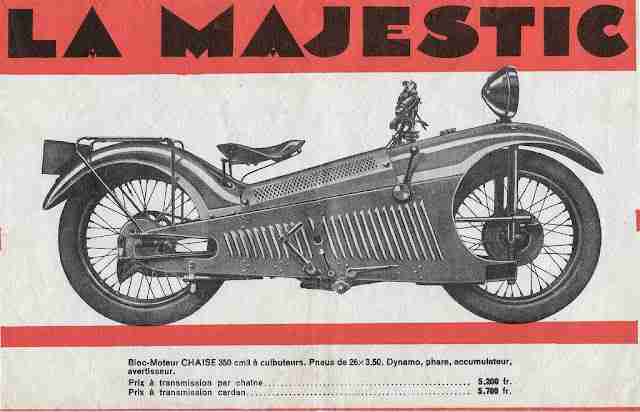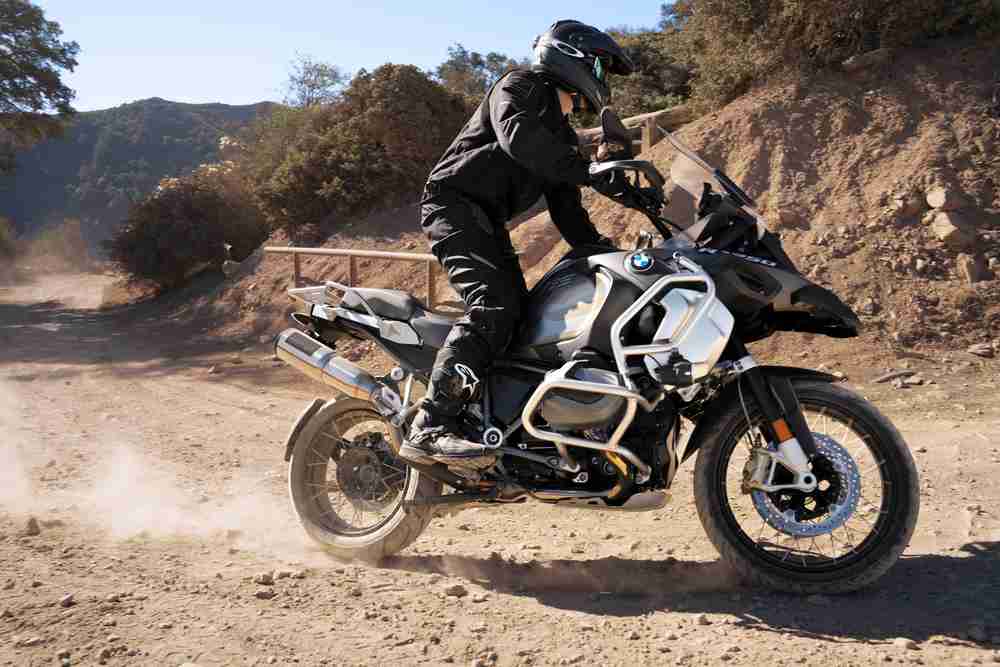Dave Currier, aged 68, on Winning Cannonball riding his 1911 Harley-Davidson
By Wayfarer |
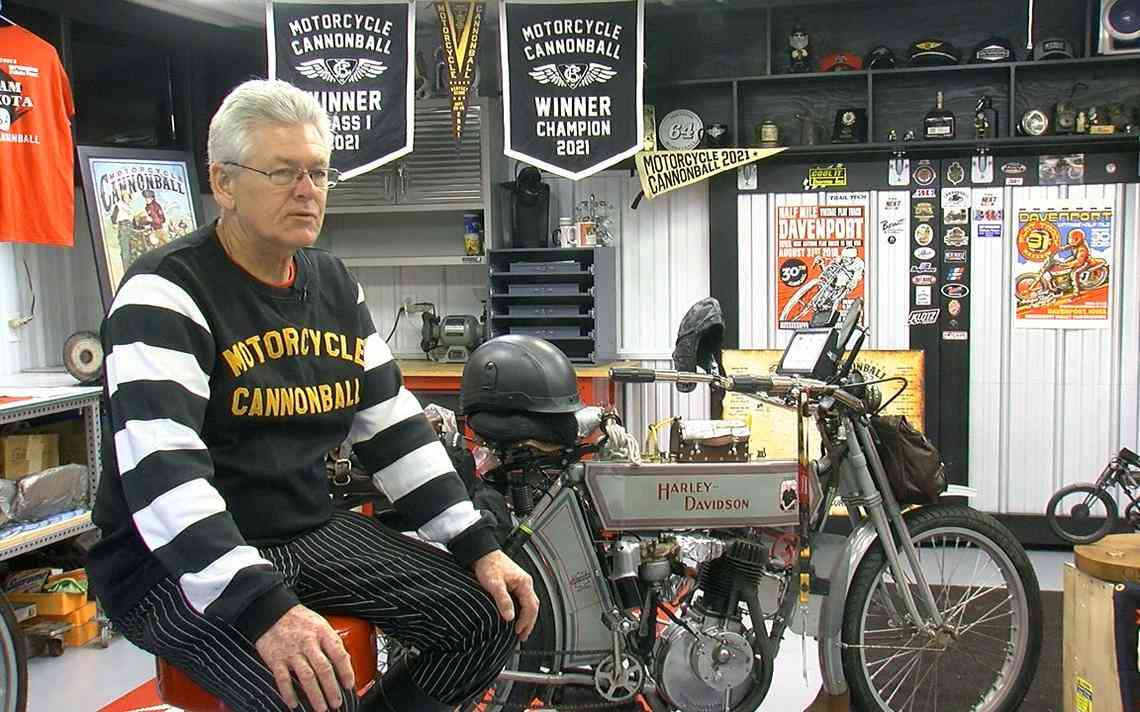 by Kevin Wallevand from https://www.inforum.com
Fargo man wins Motorcycle Cannonball with 1911 Harley Davidson
by Kevin Wallevand from https://www.inforum.com
Fargo man wins Motorcycle Cannonball with 1911 Harley Davidson
- Dave Currier turned 68 years of age on the road while racing in the Motorcycle Cannonball
- Earlier, Dave Currier had been a runner-up in 2018 Motorcycle Cannonball riding a 1915 Harley-Davidson
- His father sold Indian and Harley motorcycles in the 1940s and 50s in Fargo and also raced them
- Dave Currier credits John Rouland of Northern Crankshaft in Thief River Falls for doing a lot of the technical and engine work on his 1911 H-D
“To start it, you have to pedal to start it, it is a belt drive. To move it forward, you have a lever which tensions the belt and the bike moves forward.” – Dave CurrierFargo man wins Motorcycle Cannonball with 1911 Harley Davidson A Fargo man has just won a cross country motorcycle run called The Motorcycle Cannonball. Dave Currier is finally getting some feeling back in his rear-end. He is back in Fargo after competing in the most difficult, antique endurance race in the world: The Motorcycle Cannonball. “I think this has been the toughest ride of my life,” Currier said. “It is a real grind, I had about eight hours in the saddle every day.” Riding his 1911 belt-driven Harley Davidson, Currier and 88 competitors crossed 11 states over 16-days straight. From Michigan to South Padre Island, Texas, they racked up just over 3,700 miles. “The bike is tall. I have short legs, so my feet don’t touch the ground,” Currier said. “To start it, you have to pedal to start it, it is a belt drive. To move it forward, you have a lever which tensions the belt and the bike moves forward.” But Currier, who had a team planning and tweaking this bike, not only competed; he won. “I had a police escort, it was an absolute incredible deal,” Currier said. “They closed the roads off.” He crossed the finish line with this checkered flag, bringing home the trophy. “Before the finish, they handed me the checkered flag, and I rode in with the checkered flag,” Currier said. “It was incredible. (It’s) still hard to talk about it.” Currier credits John Rouland of Northern Crankshaft in Thief River Falls for doing a lot of the technical and engine work on the 1911 Harley. He said his local sponsors; Milwaukee Tool, Acme Tools, Dakota Fence, and TechLine Coatings all played a role in the win. Currier, who turned 68 during the race, thinks he had a little help from angels above. His dad, Dick Currier, sold Indian and Harley motorcycles in the 1940s and 50s in Fargo. He raced them as well, and Currier believes his dad would be pretty proud. “He was a big part of my life,” Currier said. “That’s why I called it, ‘The Last Ride.'” For more info on the Motorcycle Cannonball visit their website by clicking here.
Earlier Dave Currier had been a runner-up in 2018 Motorcycle Cannonball riding a 1915 Harley-Davidson
From September 2018.
“I’ve already been doing a lot of thinking,” Currier said, chuckling. “I have done the twin cylinder. The next challenge for me would be to take a single cylinder and make it across the U.S. But this was a trip of a lifetime. Going over the mountain in Kalispell, Montana, that’s when I turned 65.”‘Trip of a lifetime’: Fargo resident named runner-up in world’s hardest antique motorcycle run Currier says his bike, a 1915 Harley-Davidson twin-cylinder boasting an 11-horsepower engine, took him two years to restore. by Emma Vatnsdal from https://bismarcktribune.com
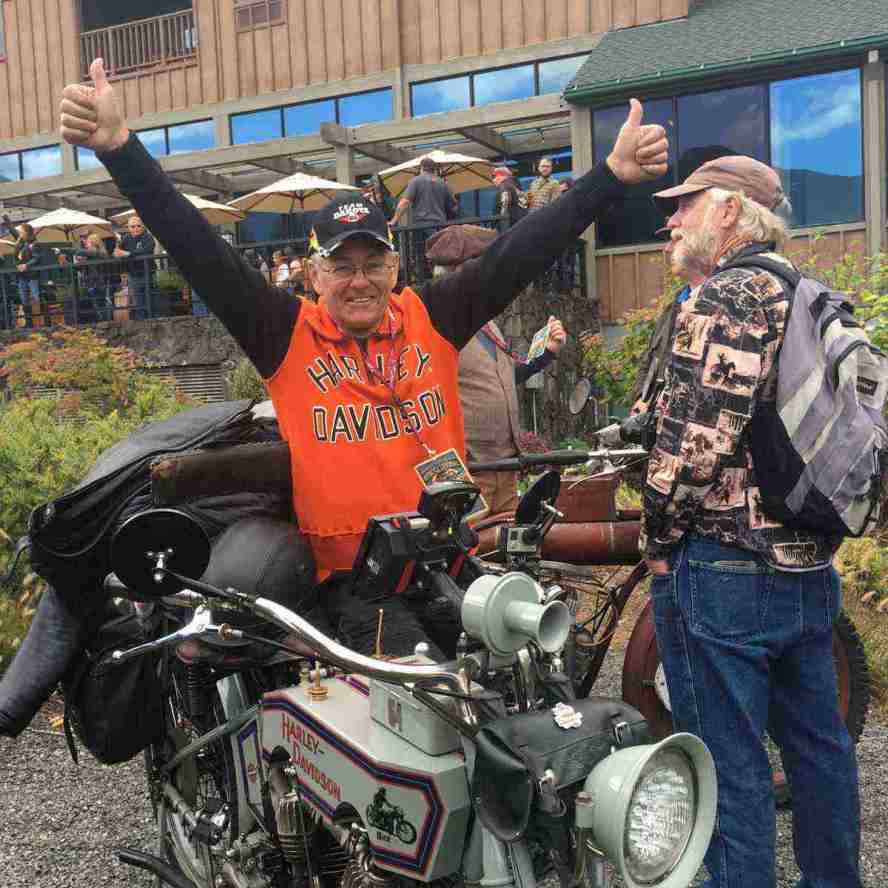 PORTLAND, Ore. — Enjoying a sunny 48-degree morning in The Dalles, Ore., Dave Currier and his entourage were getting ready late last week to point themselves east and head back home to Fargo.
While many go west to escape the cold of winter or spend time with family and friends, Currier had a different motivation — and to end up in Portland, he had to start in Portland, Maine.
In 2010, one man set out to become the first person to take a group of 45 like-minded antique motorcycle riders across the U.S. from Kitty Hawk, N.C., to Santa Monica, Calif. Sixteen days later, 10 of the original 45 riders rolled their roughly century-old bikes onto the Santa Monica Pier, completing the inaugural Motorcycle Cannonball Endurance Run.
Now in its fifth running, the 2018 installment of the run saw more than 100 people ride from Maine to Oregon, giving participants a chance to see much of the U.S. in a whole new way.
Three classes of motorcycles — single cylinder, twin cylinders with two-speed rear ends and bikes with three-speed transmissions — set out, racing to navigate the roads to each day’s checkpoint before 5 p.m. Taking only the “back roads” across the whole country, Currier and the rest of the crew averaged around six hours of riding per day beginning at 7:30 a.m.
In true-to-history fashion, modern navigation systems like a GPS device were not allowed. Instead, riders were given maps each morning 30 minutes before they set out with directions consisting instructions like “drive north 3.2 miles, turn left at the blue house and head west.”
Currier said it was a voyage to remember.
“It was incredible,” Currier said. “It was a fantastic trip kind of re-enacting what the old-time people did when they had the opportunity to go across the U.S. What was really kind of special was I had my birthday (during the trip). Going over the mountain in Kalispell, Montana, that’s when I turned 65. It was kind of a monumental trip in many ways for me.”
Lifelong passion
There are few requirements about which motorcycles qualify for this cross-country road trip, but there are standards that must be met. For the 2018 run, all motorcycles had to be manufactured in 1928 or earlier, and must still appear original in nature.
While period-correct modifications were accepted, no modern replica bikes could be entered.
Electrical charging systems, auxiliary fuel tanks and modern wheels were OK, though GPS systems were specifically banned.
Currier says his bike, a 1915 Harley-Davidson twin-cylinder boasting an 11-horsepower engine, took him two years to restore.
“I started with the basic frame and completely refurbished it from the ground up,” he said. “I’ve always enjoyed the motorcycles since I was 7 years old when I first rode one. Restoring this was pretty special.”
Safety is the No. 1 concern during this race, especially because the bikes are sometimes older than riders’ grandparents. Upon arriving in Portland, Maine, riders completed a half-day of safety classes consisting of rules of the road and safety features.
Each Cannonball rider is also allowed a support team to help them along the way. Currier chose his wife, Kay, two friends from Alaska and a co-worker to assist him with any repairs after each day was done.
“When you get done with the day and you check out, you can do any service work you want on your bike,” he said. “You can change motors, you can overhaul it, whatever you can between 5 at night and 7 in the morning. The support team can’t have anything to do with you during the day.”
Even with the small issues he faced — losing bolts, tough winds and unsoldered ground wires — Currier says he wouldn’t have placed runner-up in his class without the support of his wife and family.
“They’ve always been incredibly good,” he said. “I couldn’t have done this without them.”
The Motorcycle Cannonball Endurance Run happens every two years, and Currier said he’s started planning for 2020.
“I’ve already been doing a lot of thinking. Six to seven hours a day, you got plenty of time to think about a lot of stuff,” Currier said, chuckling. “I have done the twin cylinder. The next challenge for me would be to take a single cylinder and make it across the U.S. But this was a trip of a lifetime.”
PORTLAND, Ore. — Enjoying a sunny 48-degree morning in The Dalles, Ore., Dave Currier and his entourage were getting ready late last week to point themselves east and head back home to Fargo.
While many go west to escape the cold of winter or spend time with family and friends, Currier had a different motivation — and to end up in Portland, he had to start in Portland, Maine.
In 2010, one man set out to become the first person to take a group of 45 like-minded antique motorcycle riders across the U.S. from Kitty Hawk, N.C., to Santa Monica, Calif. Sixteen days later, 10 of the original 45 riders rolled their roughly century-old bikes onto the Santa Monica Pier, completing the inaugural Motorcycle Cannonball Endurance Run.
Now in its fifth running, the 2018 installment of the run saw more than 100 people ride from Maine to Oregon, giving participants a chance to see much of the U.S. in a whole new way.
Three classes of motorcycles — single cylinder, twin cylinders with two-speed rear ends and bikes with three-speed transmissions — set out, racing to navigate the roads to each day’s checkpoint before 5 p.m. Taking only the “back roads” across the whole country, Currier and the rest of the crew averaged around six hours of riding per day beginning at 7:30 a.m.
In true-to-history fashion, modern navigation systems like a GPS device were not allowed. Instead, riders were given maps each morning 30 minutes before they set out with directions consisting instructions like “drive north 3.2 miles, turn left at the blue house and head west.”
Currier said it was a voyage to remember.
“It was incredible,” Currier said. “It was a fantastic trip kind of re-enacting what the old-time people did when they had the opportunity to go across the U.S. What was really kind of special was I had my birthday (during the trip). Going over the mountain in Kalispell, Montana, that’s when I turned 65. It was kind of a monumental trip in many ways for me.”
Lifelong passion
There are few requirements about which motorcycles qualify for this cross-country road trip, but there are standards that must be met. For the 2018 run, all motorcycles had to be manufactured in 1928 or earlier, and must still appear original in nature.
While period-correct modifications were accepted, no modern replica bikes could be entered.
Electrical charging systems, auxiliary fuel tanks and modern wheels were OK, though GPS systems were specifically banned.
Currier says his bike, a 1915 Harley-Davidson twin-cylinder boasting an 11-horsepower engine, took him two years to restore.
“I started with the basic frame and completely refurbished it from the ground up,” he said. “I’ve always enjoyed the motorcycles since I was 7 years old when I first rode one. Restoring this was pretty special.”
Safety is the No. 1 concern during this race, especially because the bikes are sometimes older than riders’ grandparents. Upon arriving in Portland, Maine, riders completed a half-day of safety classes consisting of rules of the road and safety features.
Each Cannonball rider is also allowed a support team to help them along the way. Currier chose his wife, Kay, two friends from Alaska and a co-worker to assist him with any repairs after each day was done.
“When you get done with the day and you check out, you can do any service work you want on your bike,” he said. “You can change motors, you can overhaul it, whatever you can between 5 at night and 7 in the morning. The support team can’t have anything to do with you during the day.”
Even with the small issues he faced — losing bolts, tough winds and unsoldered ground wires — Currier says he wouldn’t have placed runner-up in his class without the support of his wife and family.
“They’ve always been incredibly good,” he said. “I couldn’t have done this without them.”
The Motorcycle Cannonball Endurance Run happens every two years, and Currier said he’s started planning for 2020.
“I’ve already been doing a lot of thinking. Six to seven hours a day, you got plenty of time to think about a lot of stuff,” Currier said, chuckling. “I have done the twin cylinder. The next challenge for me would be to take a single cylinder and make it across the U.S. But this was a trip of a lifetime.”World’s Fastest Female Motorcycle Racer
By Wayfarer |
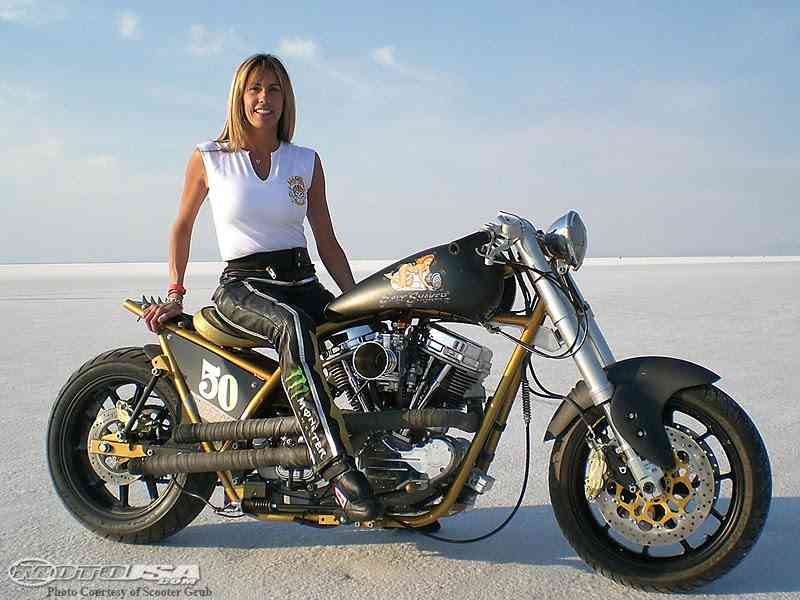
Valerie Thompson is the World’s Fastest Female Motorcycle Racer and a 10x land speed record holder with membership in the Sturgis Motorcycle Hall of Fame as well as eight 200 MPH Clubs and one 300 MPH Club.
She is consistently ranked as one of the World’s Top 10 Fastest Motorcycle Racers.
“The first time I raced at Bonneville, there were only 3 other female competitors, so we really stood out. A lot of people didn’t take me seriously until I established myself as a serious competitor capable of breaking records.” – Valerie Thompson
“I collected my first two records with team owner Keith Ball, who had a lot of faith in me and provided my first two record rides at Bonneville. Now I have Denis Manning, designer of the BUB 7 streamliner and AMA Hall of Fame member, as a mentor and team director.” – Valerie Thompson
Racing the BUB 7 during the 2018 Dry Lake Racers Australia (DLRA) Speed Week competition at Lake Gairdner, she set a new speed record of 328.467 mph (528.616 km/h) to become Australia’s fastest female streamliner motorcycle racer.
2022 Will Be a Busy Year on the Salt for Valerie.
Click Here to Read a Feature Article on Valerie on Bikernet.com
Join the Cantina for more – Subscribe Today.
Click To See the book on Building the Salt Shaker – a Panhead on which Valerie set her First Speed Record. “The Worlds Fastest Panhead ” by 5-Ball Racing Team.
WORLD’S FASTEST FEMALE MOTORCYCLE RACER” 328 MPH
By Eric Studer |

Valerie Thompson is the World’s Fastest Female Motorcycle Racer and a 10x land speed record holder with membership in the Sturgis Motorcycle Hall of Fame as well as eight 200 MPH Clubs and one 300 MPH Club. She is consistently ranked as one of the World’s Top 10 Fastest Motorcycle Racers.
Valerie is the designated rider of the famed BUB 7 motorcycle streamliner, a proven record setting vehicle designed by AMA Hall of Fame member, Denis Manning. This American-built streamliner has held the motorcycle land-speed record twice from 2006 – 2008 and again from 2009 to 2010.

Racing the BUB 7 during the 2018 Dry Lake Racers Australia (DLRA) Speed Week competition at Lake Gairdner, she set a new speed record of 328.467 mph (528.616 km/h) to become Australia’s fastest female streamliner motorcycle racer. Just days later, she experienced a horrific crash at over 360 mph during the World Speed Trials. Valerie walked away from the catastrophe that scattered wreckage for over a mile with only minor injuries, a true testimony of the vehicle’s design and safety features.

Valerie will have a busy 2022 starting with two spring testing sessions and plans to compete at the Bonneville Motorcycle Speed Trials with the BUB 7 Streamliner after a five-year rebuilding process. She will also be the designated rider at select events for both the Team Turbo Tiger Kawasaki and Motus 1650cc MSTR owned by Robert Swartz. In addition, Valerie will continue pursuing new records on four-wheels piloting the Treit & Davenport dual-engine Target 550 Streamliner.
Often referred to as “America’s Queen of Speed,” Valerie is a popular motorsports ambassador and inspiring role model. Her relentless quest to become the world’s fastest motorcycle racer by breaking the current world record of 376.363 mph (605.697 km/h) is the focus of the upcoming land speed racing documentary film, “Rockets and Titans.”
Seeking a new challenge away from racing, she started playing pickleball in February and instantly fell in love with America’s fastest growing sport. After just eight games, she built her own backyard court. What started as a new element of her fitness regime led to playing 4-5+ times a week, professional lessons, tournaments and attending LevelUp Pickleball camps. In addition to capturing new speed records, Valerie’s goals include earning a professional pickleball players rating after winning 2 Silver Medals in just her second tournament.
Valerie’s pickleball passion has generated enormous media interest resulting in cover and feature stories in USA Pickleball (Official Magazine of Pickleball by USA Pickleball Association), Bentley (Official publication for Bentley owners worldwide), Scottsdale Living, Woman Rider, and Harley-Davidson Enthusiast magazines. Her temporary pickleball court on the famed Bonneville Salt Flats, the world’s fastest racecourse, made front-page news in the Wendover-Times after a spirited game with the city’s Mayor.

Valerie is an independent racer and aspiring pickleball pro currently seeking sponsorship for her quest to break the world motorcycle speed record. Your support helps the BUB 7 team rewrite racing history by shattering barriers and speed records.
We get a lot of media questions about Valerie’s introduction to land speed racing and a woman competing in a male dominated sport. Whenever possible, Valerie insists on mentioning the mentors who played a critical role in her racing success. We don’t control what is finally printed, but here is just one example from this year:

Q&A for Rider Magazine Insider Podcast and Woman Rider profile
Being a successful woman in powersports – where the gender bias is being recognized – is a feat in itself. What was it like for you to break into motorcycle racing as a woman? “When I was just getting started, I encountered some bias not only from competitors, but potential sponsors and team owners as well. The first time I raced at Bonneville, there were only 3 other female competitors, so we really stood out. A lot of people didn’t take me seriously until I established myself as a serious competitor capable of breaking records.
“I collected my first two records with team owner Keith Ball, who had a lot of faith in me and provided my first two record rides at Bonneville. Now I have Denis Manning, designer of the BUB 7 streamliner and AMA Hall of Fame member, as a mentor and team director. So yes, I encountered some bias among males in the sport, but I’ve had many more positive experiences than negative ones. I’ve been very fortunate in land speed racing where you are judged primarily on what you achieve on the track.”
“Valerie stepped up without hesitation to ride the first sport bike 120-inch Panhead built by me around a John Reed concept configuration. It was basically a rubber-mounted FXR styled Panhead named the Salt Shaker. She rode it to over 150 mph, setting her first land speed record at Bonneville. She couldn’t wait to ride my next salt creation, the Assalt Weapan, another H-D Panhead she rode to her second land speed racing record. No doubt about it, Valerie was built for speed.”
–Keith R. Ball

As you may know, Valerie has been featured in several books over the last 18 months, including “History of Speed” by Martin Roach and “Bonneville’s Women of Land Speed Racing” by “LandSpeed” Louise Ann Noeth. Based on the types of racing and movie media questions we get, I am collecting quotes about Valerie from individuals who have worked with Valerie at various points in her career. Here are two examples:
“I’m tickled pink Valerie is being inducted into the Sturgis Motorcycle Hall of Fame. She’s paid her dues on every type of racing surface and has the records to prove it. She knows no fear, delivers on her promises and is a wonderful sponsor ambassador. I’ve worked with the best riders in the business from Cal Rayburn to Chis Carr. Valerie ranks right up there with the best of the best.”
— Denis Manning (Team “7” Racing president/BUB “7” Streamliner designer/AMA Hall of Fame member)

“All I can say is anyone playing Valerie better come prepared because that girl always does! Frankly, I would not be surprised if Valerie figured out a way to play pickleball while riding one of her many motorcycles.”
— “LandSpeed” Louise Ann Noeth (Motorsports author and land speed racer)

Since you played a key role in building the foundation of Valerie’s land speed racing success, we want to ensure you are properly recognized. I have just one more question.
How would you like to be referred to when asked? (BikerNet.com founder, Team owner, Bike tuner, etc)
Who came up with the name ‘Assalt Weapan?’
“I’m the founder of Bikernet.com and 5-Ball Racing Team, President of 5-Ball Inc. I built the two bikes Valerie rode to her first two records. That year 2006 was the first time I returned to Bonneville after 16 years. The last time I was 1990, and I was on the Easyriders team and the Editorial Director of Easyriders Magazine. We set the Motorcycle World Land Speed Record at 321 mph and held the record for 16 years, until 2006.

That year was amazing for many reasons. With Valerie we set another World Land Speed Record. And next year 5-Ball Racing will head back to the salt with the “Salt Torpedo,” the first Streamlined Trike base inside an historic belly tank and piloted by Micah McCloskey. Note the name. The Bonneville Salt Flats naturally lends itself to amazingly appropriate titles, which adds to the fun of racing on 65 square miles of salt.
Berry Wardlaw, the founder of Accurate Engineering, was our tuner during two record years 2006 and 2007. Wouldn’t it be interesting if Valerie was the first woman to set the motorcycle world land speed record.
–Keith R. Ball

For details on sponsorship opportunities, speaking engagements and celebrity appearances, email: Valerie@ValerieThompsonRacing.com
Honda Motorcycle bought in 1981 with zero miles in original condition
By Wayfarer |
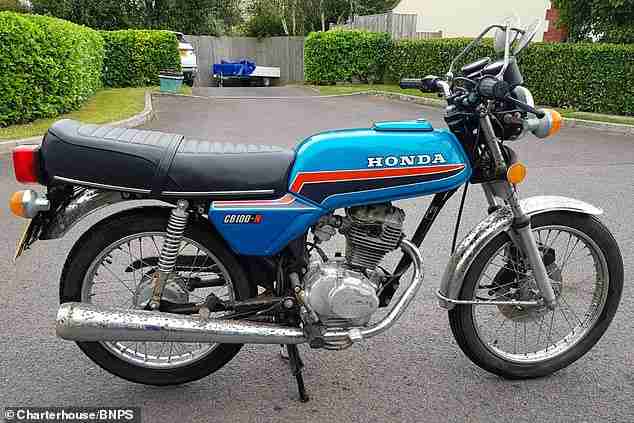
Honda motorbike bought in 1981 that has zero miles on the clock because it was confiscated by its teenage owner’s father and locked in garden shed goes up for auction for £2,000
- Honda CB100N was bought 40 years ago but was never ridden by its teen owner
- Strict father banned him from riding it and it stayed untouched locked in storage
- After father died, son found his bike in remarkable condition four decades later
- The 1981 bike is now going up for auction and is expected to fetch up to £2,000
by Katie Feehan from https://www.dailymail.co.uk
A 40-year-old Honda bike with no mileage on it has been rediscovered and is up for auction after the disapproving father of its first teen owner banned him from riding it and locked it away in storage for decades.
The 1981 Honda CB100N was bought brand new by the youngster in his youth while he lived with his parents.
However, his boyhood fantasy of riding a motorcycle never materialised because his strict father banned him from riding it.
Instead the machine was left to languish in storage for the next four decades.
After his father died the unnamed owner, who is now aged in his 50s, was tasked with clearing out his house in Bridgewater, Somerset, and stumbled upon his old but immaculate bike.
He agreed to sell the time-capsule Honda to neighbour Graham Tozer who has now put it up for sale at auction.
The bike still has its original tax certificate with an expiry date of July 31, 1982. The odometre displays the exact mileage of a mere four tenths of a mile.
Mr Tozer, 64, said: ‘I’m a collector of classic bikes and cars, so six months ago my neighbour called me up and said they needed rid of it.
‘He was born in the house and spent all of his life there. When he was a youngster he really wanted his own bike but when he brought it home his dad wouldn’t let him ride it.
‘He’d saved up for such a long time to buy it but his father just said, ‘you’re not going on that. You can stick it in the shed’.
‘Apparently his dad was really strict. He was ex-military and he was the boss of the house.
‘I would have loved a bike like that when I was younger but my dad probably would have done the same thing.
‘To have a motorbike from the eighties which hasn’t been touched is so unique. It really is like the Holy Grail for collectors.’
George Beale, a specialist at Charterhouse Auctioneers of Sherborne, Dorset, said: ‘These bikes were ordinarily used for commuting, so those which are still on the market from the 1980s tend not to be in the greatest condition.
‘But with a little work this one could be like brand new, which is incredibly unusual for something so old.
‘It would be rare to find any vehicle from the 1980s without any miles whatsoever. It just so happens that this young boy’s tyrant father was far more forceful than he was.’
The Honda is being sold with a pre-sale estimate of £2,000 at the Haynes International Motor Museum on October 14.
What is Hub-center Steering Motorcycle & Why it is Better
By Wayfarer |
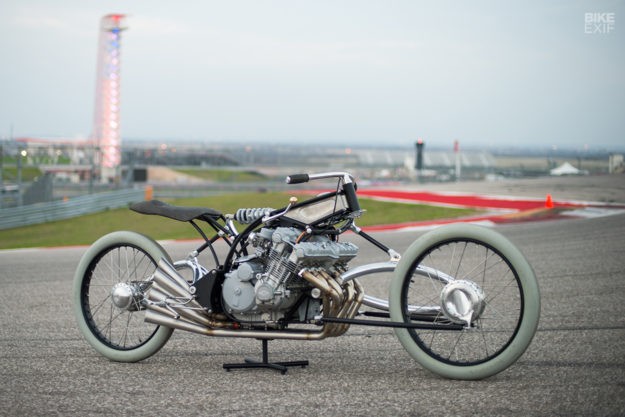
by Todd Halterman from https://www.autoevolution.com
Hub-center steering is one of several different types of front-end suspension and steering mechanisms used in motorcycles and cargo bicycles. It is essentially a mechanism that uses steering pivot points inside the wheel hub rather than a geometry that places the wheel in a headstock like the traditional motorcycle layout.
Perhaps the most venerable example of the idea came in the form of the 1930 Majestic. This Georges Roy design used a novel pressed-steel monocoque chassis, and it incorporated an automotive-type chassis with hub-center steering. Other bikes had already used the configuration in such machines as the Ner-A-Car and the Zenith Auto-Bi, but the Majestic made it lovely to behold.
Another bike, the Vyrus 984 C3 2V Razzetto, was one such motorcycle that used hub-center geometry.
Vyrus is a small Italian motorcycle manufacturer based in Coriano, Italy, and their bikes such as the “Tesi” – Thesis in Italian – had their designs originate from a university engineering project linked to the motorcycle legend Massimo Tamburini. The Tesi, and the Vyrus 984, were instantly identifiable by their use of their hub-center steering front suspension and steering arrangement.
Those fabulously expensive bespoke motorcycles have been called “functional works of art,” and they look a bit like something you might see in a video game.
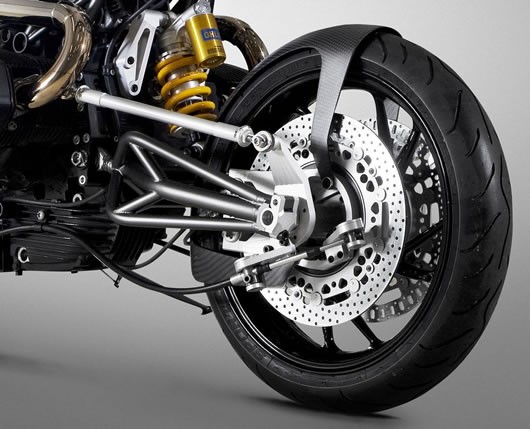
In hub-centered bikes, the front wheel is attached to a swingarm with a shock and an internal pivot point. Steering is achieved using those linkages to turn the wheel on a pivot point. Hub-center steering has been employed on motorcycles for more than a century, but the design, despite what some engineers say offers a distinct advantage, never took hold.
But the founder of Vyrus, Ascanio Rodorigo, once worked for Bimota as a race mechanic and engineer during the 1970s and his tenure there lasted until 1985. When Rodorigo finally left Bimota, he started his own company but partnered with Bimota on the hub-center-steered Tesi. He then went on to take the steering concept deeper and refined it for his own company’s motorcycles.
A Ducati dual spark bored out to 1,079cc and making 100hp L-twin provides the power for the 319 lbs (145 kg) Vyrus 984 bike, and it’s delivered to the road for via a six-speed transmission.
Now builders like Bryan Fuller of Fuller Moto, Revival Cycles, and others have built beautiful machines which harken back to the hub-centered glory days of the Majestic. Builders such as Stellan Egeland used a hopped-up 1200 boxer engine from a BMW HP2 Sport. He also added his own hub-center steering setup from ISR to a frame he made from a 2391 steel tube. The ISR kit is a thing to behold.
Revival’s ‘The Six,’ which features a ballsy Honda CBX motor, is another take on the hub-steer geometry. It was commissioned by museum owner and bike collector Bobby Haas for his Haas Moto Museum in Dallas and made by Revival’s Alan Stulberg and his crew.
Stulberg said the commission was aimed at paying homage to the Art Deco classic Majestic and added that he and the team became “obsessed with its design language and flow” since they first saw the bike at the Barber Museum.
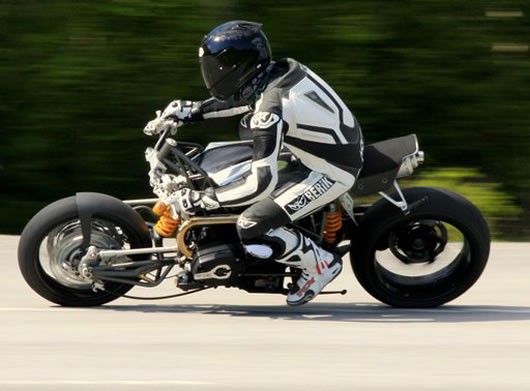
Hub steering systems don’t dive as much under braking and hard cornering as do conventional telescopic fork setups. They push braking forces back into the chassis more efficiently rather than transferring immense bending forces to a pair of upright forks. The ride experience is exceptional as braking performance throughout corners is greatly enhanced.
It works like this: A wheel hub pitches back and forth on a central pivot and is supported by two large steering arms actuated by handlebars. The handlebars connect to the front steering and swingarm using complex linkages. A fixed arm connects a pull-and-push rod on either side of the hub-center to help steer the bike. The geometry also includes a second pair of static rods to ensure the axle stays level with the bike’s mass.
While hub steering has a number of clear advantages, its downfall is that it is considerably more expensive to manufacture and maintain and requires exceptionally experienced mechanics to tune and repair.
But it does look good, works more efficiently from an engineering standpoint, and directly addresses the most important factor in the motorcycling experience: braking.
The Majestic – Artistic Design from the 1920s
from https://www.odd-bike.com
While the engineering of the Majestic might have been relatively conventional, what was unprecedented was the styling, the hallmark of the Majestic to this day.
All the oily bits were fully enclosed under louvered panels, with partially enclosed fenders covering the wheels at both ends. The rider was completely isolated from the grime and muck of the running gear and powertrain, perched upon a sprung saddle and controlling the machine via levers and bars that poke through the all-encompassing body.
Presented in 1929, the prototype Majestic (which was reported as Roy’s personal machine) featured an air-cooled 1000cc longitudinal four-cylinder engine from a 1927-28 Cleveland 4-61. This would not remain for production, however.
While at least two Majestics were built with a 750cc JAP V-twin (arranged, like a much later Moto-Guzzi , with the Vee transverse and the heads poking through the bodywork) and records note that JAP singles, a Chaise Four, and at least one Gnome et Rhone flat twin were also employed, the majority of production machines coming out of Chartenay featured air-cooled Chaise engines.
These were overhead valve singles featuring unit two or three-speed gearboxes operated by hand-shift, available in 350cc and 500cc displacements. Distinctive for their single pushrod tube that resembles a bevel tower (but contains a pair of tightly-spaced parallel pushrods) and external bacon-slicer flywheel, these powerplants were a favourite of French manufacturers during the interwar period and were used by a variety of marques in lieu of producing their own engines.
The base price of the Majestic was 5200 Francs for a 350 with chain final drive; an extra 500 Francs netted you optional shaft drive.
An additional option that is rarely seen on surviving examples was a fine “craquelure” paint option that was applied by skilled artisans. It involves a process of deliberately screwing up the paint job in the most controlled and flawless way possible, applying a contrasting top coat over a base using incompatible paints that will cause the top coat to crack in a uniform fashion, something like a well-aged oil painting or antique piece of furniture.
The result is spectacular – and perhaps a bit tacky, giving the machine the appearance of a lizard skin handbag. (Maybe a later Rock Star would have loved to ride it as the “The Lizard King” ? )
The Majestic was impeccably stable at higher speeds compared to the other motorcycles of that era.
It was also agile and light footed in a way that similar machines, like the Ner-A-Car, were not.
The relatively low weight, around 350 pounds, carried with a very low centre of gravity made for tidy handling that was more than up to the meagre output offered by the powerplants.
Majestic was targeting a clientele that didn’t really exist: the gentlemanly rider who might desire a superior (read: expensive) machine as a stablemate to their elegant automobiles.
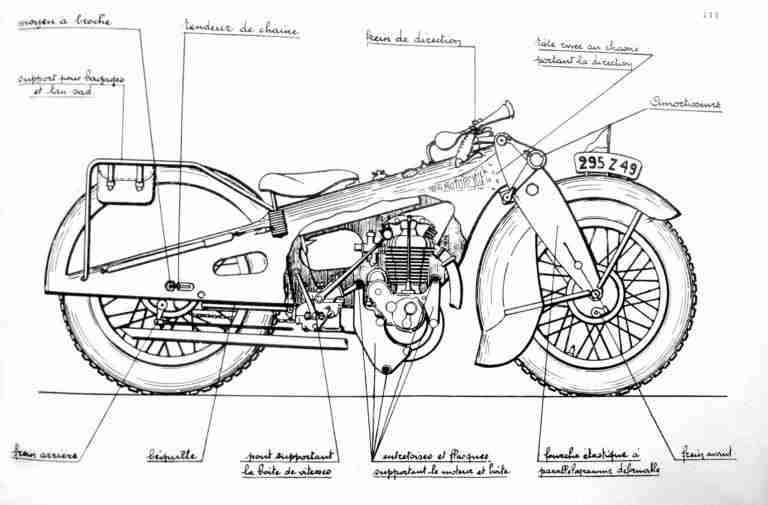
Georges Roy’s earlier 1927 brand called New Motorcycle was a far better barometer of things to come, predicting the style and design of machines that would emerge during the 1930s and beyond. The Majestic has far less impact and was more of a curiosity than predictor of trends to come.
Georges Roy’s brilliance as a designer is unquestionable, and deserves more praise than he ever earned during his lifetime.
Majestic is a little bit of elegance floating on the sea of staid machines that clutter up the history books.
Georges Roy was a French industrialist and engineer born in 1888 who achieved success in the textile business – specifically in knitting and sewing equipment. He was, however, an early adopter of motorcycling at the turn of the 20th Century – reportedly his first machine was a Werner, a Parisian machine that introduced the term “Motocyclette” in 1897.
The Flying Wrens: Sisterhood of Motorcycling Heroes
By Wayfarer |
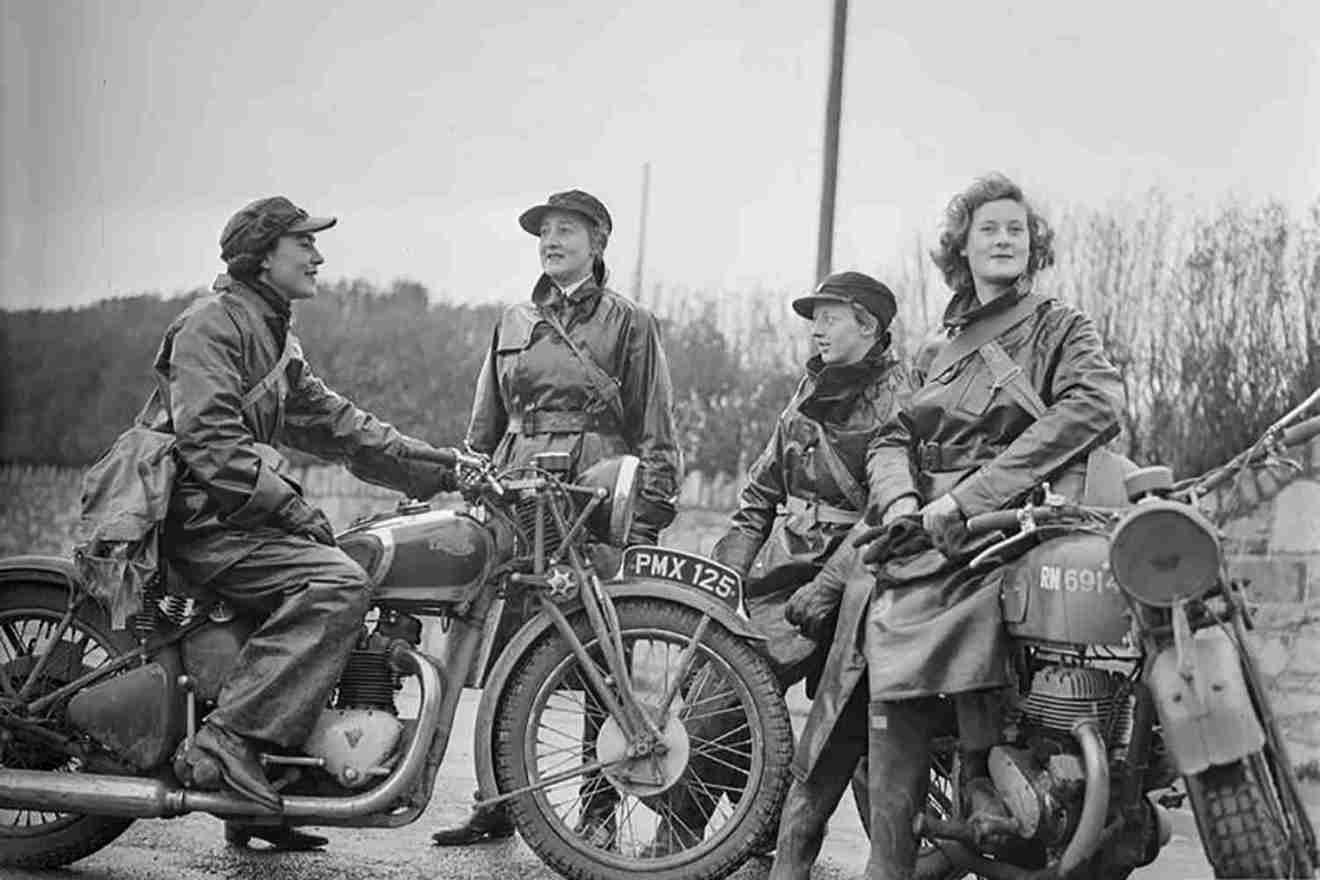
All-Female British dispatch riders of WW-II
Originally, the Women’s Royal Naval Service (WRNS) was formed in 1917, during WW-I.
Riding on narrow British roads in all weather conditions can be a dangerous enough occupation. Doing so around the clock during WW-II with the German Blitz going on around you required steel nerves.
The bikes used were mostly small, single-cylinder affairs, built specifically for military use.
Click Here to Read this Feature Article & Historic Photos on Bikernet.com
Join the Cantina for more – Subscribe Today.
https://www.bikernet.com/pages/custom/subscription.aspx
The Flying Wrens: Sisterhood of Motorcycling Heroes
By Bandit |

We do not know what message W.R.N.S. Third Officer Pamela McGeorge carried, only that she rode through hell and flame like a woman possessed. A bomb fell close, the blast knocking her from her bike, sprawling and sliding. She picked herself up, ran back—the motorcycle was a tangle of bent metal. She hefted her bag, turned, and ran the rest of the way to deliver the message.

Originally, the Women’s Royal Naval Service (WRNS) was formed in 1917, during WWI. The Navy was the first of Britain’s armed forces to actively recruit women, and the Wrens, as they became known, were telegraph operators, clerks, and code experts. The director of the Wrens was the highly capable Dame Katharine Furst, who was later both an expert skier and head of the World Association of Girl Guides and Scouts.
It’s worth noting that Wren McGeorge had been a Sea Ranger, the Naval equivalent of a Guide. There was a great deal of overlap between the Guiding movement and the various WWII women’s auxiliaries. Girls who had grown up learning to be skilled and independent were not about to sit at home while a war was on.

The WRNS organization was fortunate at first in having a small pool of experienced women motorcyclists to draw on. During the prewar period, society on the whole didn’t exactly encourage women to take up motorsport, but more than a few did anyway.

Wallach was a skilled engineer who would spend WWII as both a dispatch rider for the Army auxiliaries and as a tank mechanic. Shilling was also a highly regarded engineer and invented a simple device that helped keep the Merlin V-12s of early Spitfires from losing fuel pressure during negative-g maneuvers; the invention put British fighter pilots on an even footing against the fuel-injected German fighter planes.

As a brief aside, it should be noted that Queen Elizabeth II learned to ride and maintain a motorcycle as part of her 1945 military service. If you happen to be riding in the vicinity of Balmoral and another rider waves at you in that odd, swivel-wristed way, perhaps it’s her!

The bikes used were mostly small, single-cylinder affairs, built specifically for military use. BSA, Royal Enfield, and Triumph all produced motorcycles in the 250cc–350cc displacement range, each with modest power. But the bikes were light and agile, perfect for the narrow English country lanes and city streets.

This time, after the war ended, the WRNS was not disbanded. Instead, it continued until 1993, when it was eventually absorbed into the British Navy. Dame Matthews retired once the decision was confirmed. In an alcove in Westminster Cathedral, you can find a statue of St. Christopher holding a boat. Upon the boat’s anchor is perched a small wren.
As for the dispatch riders themselves, with wartime over, eventually their services were no longer required. Some returned to civilian life, hanging up their riding outfits for the last time. Some had found new passion and freedom on two wheels. Theresa Wallach, though dispatch riding for the Army rather than the WRNS, continued to ride motorcycles until she was 88 years of age. She died on April 30, 1999, her 90th birthday.


Rider Review: New Saddlemen Heated Seat
By Wayfarer |
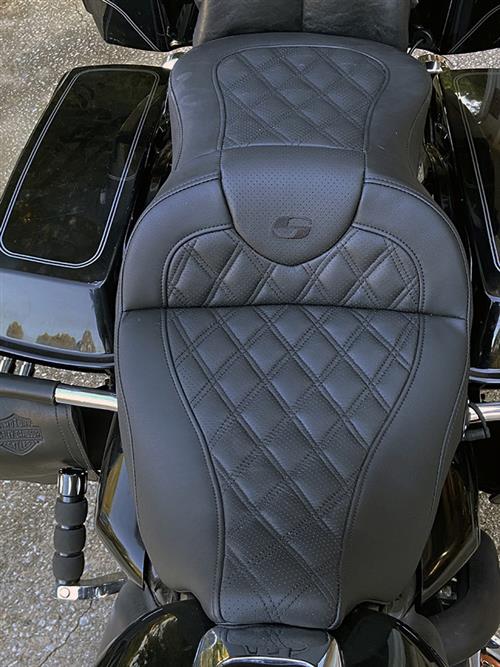
Making Every Ride More Comfortable
Photos and text by Rogue
“I get to ride all over the country and in all kinds of weather. I have made many changes to my 2009 FLHTC over the years and one of them was to install a Saddlemen Heated Seat.”
“I purchased this new Saddlemen seat and installed it on 9/23/2021.”
“Saddlemen has a wide assortment for many motorcycle models”
– Rogue
Click Here to See The Installtion Process and Features of the New Saddlemen Heated Seat.
Join the Cantina for more – Subscribe Today.
https://www.bikernet.com/pages/custom/subscription.aspx
Vance & Hines Launches Exhaust for BMW R1250 GS Motorcycles
By Wayfarer |
Vance & Hines Launches Exhaust for BMW R1250 GS Motorcycles and
Announces New Proving Grounds Facility in Mojave Desert
Santa Fe Springs CA – October 1, 2021 – Vance & Hines, America’s premier manufacturer of motorcycle performance equipment, today introduced its first exhaust product for BMW R 1250 GS and GS Adventure motorcycles. In addition, the company announced the opening of a new Off-Road Proving Grounds in the Mojave Desert.
The exhaust for BMW adventure touring motorcycles (ADV) is the company’s second product in this category, following the recent announcement of an exhaust designed for the new Harley-Davidson Pan America.
The Vance & Hines Hi-Output Adventure 500 is the largest capacity exhaust ever made by Vance & Hines, manufactured with a 5-inch diameter, high-grade, 304 stainless steel tube. The system features a brushed, works-style finish, a CNC-machined, billet aluminum endcap, black heat shield, stainless mid-pipe, spring clip assembly, and Vance & Hines new adventure badging, while having a lower weight than the stock exhaust. The stepped exhaust delivers smooth tractable torque throughout the powerband. The glass-wrapped, perforated baffle core design delivers a rich, smooth rumble while still meeting SAE J2825 sound level standards. In addition, the system is 50-state emissions compliant.
The Hi-Output Adventure 500 will be shown to riders at the BMW Motorad GS Trophy Qualifier USA West this week. The challenge is one of two US qualifying events to select riders to compete in the International GS Trophy 2022, the ultimate adventure riding skills competition in Albania next year. Vance & Hines staff will help support the event which is at RawHyde Adventures in Castaic, California.
“BMW riders are the core of the ADV bike world and we know they will love this new Vance & Hines exhaust,” said Mike Kennedy, president of Vance & Hines. “More performance, a great look and more rider comfort are attributes every rider can appreciate.”
The Vance & Hines Hi-Output Adventure 500 is priced at $699.99 and will be available late in 2021.
Vance & Hines Off-Road Proving Grounds to Open Late this Year
Vance & Hines also announced the creation of the Vance & Hines Off-Road Proving Grounds (ORPG) at the well-known Zakar Overland Terrain Park and Event Center in the Mojave Desert, about two hours from the company’s Santa Fe Springs, California headquarters. The ORPG will be the company’s private test site for off-road products. The ORPG will include a test lab and service facility where company R&D staff will develop and evaluate future Vance & Hines Off-Road products.
“We are focused on bringing Vance & Hines exhilaration to all types of off-road riders. Our new proving grounds is an example of our commitment to create a steady flow of great products for off-road fans,” continued Kennedy.
Follow Vance & Hines social media for updates from the GS Trophy Qualifier USA West this weekend. Facebook, Instagram, YouTube
About Vance & Hines
The Vance & Hines brand has always been about enhancing the exhilaration of the motorcycle ride. It started over 40 years ago, when Terry Vance and Byron Hines were two young enthusiasts in the fledgling Southern California motorcycle drag race scene. Terry always wanted to go faster and Byron knew how to make that happen. In short order, their on-track success and innovation drew the attention of other racers, riders and motorcycle manufacturers, which ultimately translated to commercial demand for their products and services. Today, the Company’s mission and activity is the same; make bikes go faster on the racetrack and take those learnings to make impactful products for riders around the world. Since the Company’s inception in 1979, it has run factory race programs in partnership with Suzuki, Yamaha, Ducati and Harley-Davidson in drag racing, road racing and flat track. Vance & Hines is based in Santa Fe Springs CA and has its Racing Development Center in Brownsburg IN. Learn more about the company’s history and products at www.vanceandhines.com.
Congress passes extension of Highway Bill
By Wayfarer |

Congress Kicks the Can…
30 day Highway Bill Extension Passes
With the failure of Congress to pass a new highway bill, by the September 30th deadline, nearly 3,700 United States Department of Transportation staffers were furloughed on Friday. Most of these workers belong to the Federal Highway Administration (FHWA) and the Federal Transit Administration (FTA).
Without dedicated funding to operate, those agency workers were forbidden from coming into work on October 1st. Operations in these agencies, related to safety and construction projects, were halted as a result.
On Friday evening, in an effort to end the closure of these agencies, Congress passed an extension of the recently expired FAST Act. The 30-day extension releases federal funds so workers at the FHWA and FTA can return to work for the month of October.
An interparty fight between progressive and moderate Democrats created a stalemate on infrastructure legislation and produced the need for an extension.
This is the second time the FAST Act has been extended in just over a year. The original 2015 bill, expired on September 30, 2020, but was given a full 1-year extension, creating the recently passed September 30, 2021, deadline.
The Motorcycle Riders Foundation (MRF) remains engaged with lawmakers on this important bill. The MRF continues to stress the need for action on the transportation policy priorities of the nearly 10 million bikers across the country. We will keep you updated as events warrant.
Visit Motorcycle Riders Foundation website at http://mrf.org


